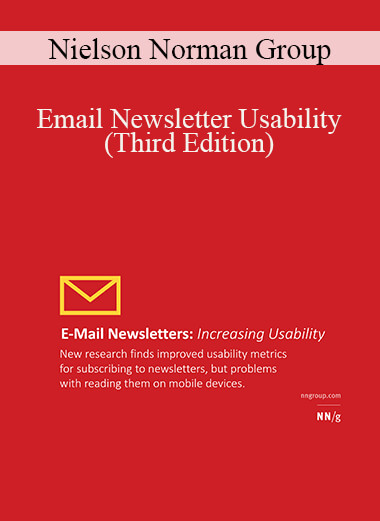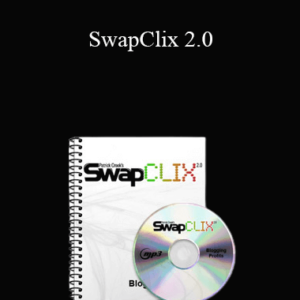Email Newsletter Usability
165 Design Guidelines for Newsletter Subscription, Content, Account Maintenance, and RSS News Feeds Based on Usability Studies
Users have highly emotional reactions to newsletters. This is in strong contrast to studies of website usability, where users are usually much more oriented towards functionality. Even a website that you visit daily will feel like a tool where you simply want to get in and get out.
The positive emotional aspect of newsletters is that they can create much more of a bond between user and company than a website can. The negative aspect is that usability problems have much stronger impact on the customer relationship than they normally do.
Users spend 51 seconds reading the average newsletter. The layout and writing both need superb usability to survive in the high-pressure environment of a crowded inbox.
Averaged across our study, newsletters lost 19% of potential subscribers due to usability difficulties in their subscription processes and designs. People often stay subscribed to newsletters they don’t want (cursing the sender with every new issue that clutters their inbox), so the unsubscribe process is also worth improving.
Newsletters need to be smooth and easy: they must be seen to reduce the burdens of modern life. Even if free, the cost in e-mail clutter must be paid for by being helpful and relevant to users – and by communicating these benefits in a few characters in the subject line.
This report shows what happened when real people used a broad set of real newsletters: trying to get on and off the subscription lists, maintaining their subscriptions, and receiving issues in their inboxes (sometimes opening the newsletters and sometimes scanning or reading them).
> executive summary of the report
> sample chapter as thumbnail pages
The 165 design guidelines in the report are based on usability tests of 228 email newsletters. User testing was mainly conducted in the United States (in 12 states across the country) but we also studied users in Australia, Hong Kong, Japan, Sweden, and the United Kingdom. 101 newsletters were studied in the users’ own environment, focusing on the user experience of receiving and reading newsletters. These newsletters were about equally divided between business newsletters and personal newsletters.
The following 22 newsletters were tested exhaustively in the usability lab:
- AdAge.com: AdAge Daily (daily industry news)
- Allrecipes.com: Daily Dish (cooking advice)
- Bankrate.com: Frugal News (financial information)
- BNET: Business Tools for Busy Leaders (weekly management info)
- Cooking.com: All About Shopping (retail)
- Dictionary.com: Word of the Day (reference)
- The Economist: The World This Week (weekly news)
- Entertainment Weekly: EW Monitor (daily specialized news)
- Fodors.com (weekly travel advice)
- Handspring (consumer electronics customer newsletter)
- The Herman Group: Trend Alert (weekly consulting insights)
- ManhattanUsersGuide.com (daily local entertainment guide)
- Morningstar: Technology Bytes (twice-weekly investment advice)
- MSNBC: Breaking News Email (daily news)
- New York City Parks and Recreation: The Daily Plant (update from municipal department)
- New York Times: Books Update (weekly book reviews)
- Overstock.com: O-Mail (e-commerce)
- Site 59: Top Picks (travel deals)
- SmarterTravel.com: Last Minute Airfares (travel deals)
- USAToday.com: Daily Briefing (news headlines)
- WineLoversPage.com: The 30 Second Wine Advisor (weekly wine tips)
- Zacks.com: Profit from the Pros (investment advice)
The remaining newsletters were tested with a few users each. This is particularly true for the B2B newsletters which were often so specialized that only a few study participants received any given newsletter.
The report is richly illustrated with 353 color screenshots of newsletters and subscribe/unsubscribe screens that worked well or caused problems in user testing, including eyetracking heatmaps showing where users looked when reading newsletters. The screenshots show examples and best practices from 118 different newsletters and websites. (228 newsletters were tested, but not all are shown in the report.)
Comparing the Editions
If you already own the first edition of this report, should you buy the third edition? Probably yes, because the combined number of new findings in the second and third edition is substantial.
If you own the second edition, we only recommend buying the third edition if e-mail newsletters are your main job focus or if you publish a news feed (RSS). For people who are less heavily engaged in e-newsletters, there is no reason to spend time and money on the third edition if you have the second edition. The most important guidelines were included in the second edition and none of the findings in the second edition were invalidated in the third study.
Comparison of the editions:
| 1st edition | 2nd edition | 3rd edition | |
| Guidelines | 79 | 127 | 165 |
| Page count | 186 | 293 | 544 |
| Screenshots | 109 | 165 | 353 |
| Report file size | 5 MB | 9 MB | 15 MB |
| Newsletters tested | 10 | 111 | 228 |
| Methods | Lab testing | Diaries | Eyetracking, field studies |
| Emphasis | B2C | B2C and B2B | B2C and B2B, RSS news feeds |
Table of Contents
544-page report
- Executive Summary
- User research
- High nominal usability
- Low perceived usability
- Speed matters
- Improving usability
- Significant platform diversity
- Spam is a fact of life
- The battle for the inbox
- Scannability and immediate utility
- RSS/news feeds
- Future of email newsletters
- Overview of the Usability Studies
- First study
- Second study
- Third study
- About this report (third edition)
- Email and Newsletters
- Managing multiple accounts
- People are overwhelmed with information
- Email maintenance
- Saving newsletters
- Quality and efficiency matter
- Newsletters are personal and social
- Users are quick to jump to unfavorable conclusions
- Users are fighting spam
- A new way to unsubscribe
- Using Newsletters
- Benefits of email newsletters
- The downside of newsletters
- Signing up for newsletters
- Selecting messages from the inbox
- Skimming is reading
- What users read
- How often users read newsletters
- Forwarding newsletters
- Business Newsletters
- Business relationships
- Making or influencing business purchase decisions
- Personalization in business newsletters
- RSS (Real Simple Syndication or Rich Site Summary)
- Interpreting the Study Data
- Amount of email and spam
- Number of newsletters
- Time to read newsletters
- Time to subscribe and unsubscribe
- Success rates
- Subscription
- Link name and placement
- 11 design guidelines
- Subscription process
- 29 design guidelines
- Confirming subscriptions
- 10 design guidelines
- Respecting subscribers
- 2 design guidelines
- Link name and placement
- Newsletter Content and Presentation
- Most valuable newsletters
- Least valuable newsletters
- Frequency and delivery
- 5 design guidelines
- Sender and subject line
- 6 design guidelines
- Content and writing
- 18 design guidelines
- Presentation and design
- 19 design guidelines
- Links
- 10 design guidelines
- Other newsletter elements
- 6 design guidelines
- Encouraging new subscriptions
- 5 design guidelines
- Advertising
- 3 design guidelines
- Subscription Maintenance and Unsubscribing
- Links and maintenance options
- 12 design guidelines
- Unsubscribe process
- 11 design guidelines
- Links and maintenance options
- How to Avoid Being Mistaken for Junk Mail
- 12 guidelines from other sections in the report plus 2 additional design guidelines
- RSS (News Feeds)
- Promoting RSS news feeds
- 9 design guidelines
- News feed content
- 7 design guidelines
- Promoting RSS news feeds
- Sites with Good Design Examples
- Screenshots of Users’ Highly Rated Newsletters: Second and Third Studies
- About the Sites Studied
- About Participants
- Methodology: First Study
- Usage order
- Session location
- Test tasks and discussion
- About using this methodology: First study
- Telling users what to expect
- Matching user interests
- Phone call
- Forwarding newsletters
- Reading new newsletters
- Scheduling and compensation
- Unsubscribing
- Methodology: Second study
- Pilot study
- Recruiting and participation
- Sample email messages
- About using this methodology: Second study
- Methodology: Third Study
- Pilot study
- Recruiting and participation
- Usage order
- Tasks and questions
- Field studies
- About Using This Methodology: Third study
- Using the eyetracking technology
- Setting up inboxes
- Accessing users’ email accounts
- Matching users’ interests
What You Get
- Checklist of 165 specific design recommendations: review your subscription interface and your newsletter designs for these 165 best practices, and you will discover several things that need improvement.
- The average website typically violates about half of our usability guidelines. You might have the one perfect site in the world that does everything right, but the odds are against you. It is safest to score your designs against a checklist of usability guidelines to make sure you don’t do anything wrong.
- Description of how people behave when subscribing, receiving email, and reading email, including extensive quotes (often colorful, because they were often annoyed). Learn from the users’ comments and reactions to common design mistakes in the newsletters we tested.
- 353 screenshots of email newsletters and subscriptions screens with descriptions of why they worked well for users or caused them problems in usability testing.
- $340,000 of user research at 0.1% of the cost.
- Test methodology description, allowing you to run your own user tests of your own newsletters.
- Knowledge to make your newsletter cut through customers’ information overload; thus getting read more often. Avoid the negative reputation that follows from a newsletter that annoys users and feels like clutter instead of customer service.
Who Should Read This Report?
- Anybody who is responsible for the design, implementation, or strategy for email newsletters.
- Newsletter editors.
- Internet marketing managers.
Running a similar series of usability studies yourself to collect comparative design lessons from hundreds of newsletters in multiple countries would cost about $340,000.
Please help us continue publishing low-price reports by buying a site license if you have colleagues who will read the report. If you only need it for yourself, then that’s obviously what the single-user license is for. If somebody “gives” you a copy, then please buy a download anyway to keep prices down in the future.
Get download Nielson Norman Group – Email Newsletter Usability (Third Edition) at coursesblock.com right now!
Delivery Method
– After your purchase, you’ll see a View your orders link which goes to the Downloads page. Here, you can download all the files associated with your order.
– Downloads are available once your payment is confirmed, we’ll also send you a download notification email separate from any transaction notification emails you receive from coursesblock.com
– Since it is a digital copy, our suggestion is to download and save it to your hard drive. In case the link is broken for any reason, please contact us and we will resend the new download link.
– If you cannot find the download link, please don’t worry about that. We will update and notify you as soon as possible at 8:00 AM – 8:00 PM (UTC 8).
Thank You For Shopping With Us!






![[Download Now] Option Alpha Signals](https://coursesblock.com/wp-content/uploads/2024/10/Option-Alpha-Signals-1-300x300.png)
